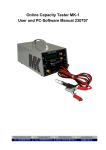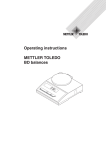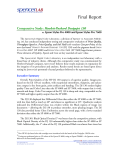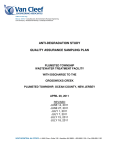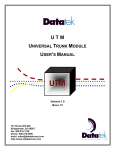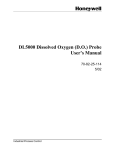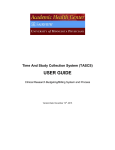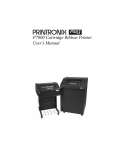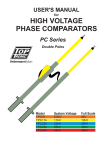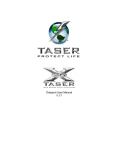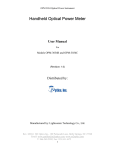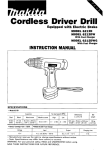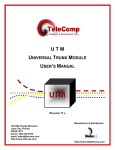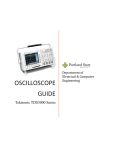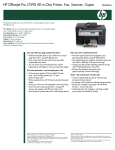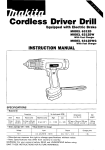Download Testing of Conducted Energy Weapons CPRC
Transcript
Restricted Distribution – Protected A Testing of Conducted Energy Weapons CPRC CEW Test 004 Reference OPCC file 2587 Victoria Police Department, Victoria British Columbia Attention: Sergeant Kerry Panton Performed April 18, 2008 Testing performed by: Sergeant Mark Barclay and Constable Michael Azar of the Ottawa Police Services Written by: Steve Palmer P. Eng , Executive Director, Canadian Police Research Centre 22 July 2008 Submitted by Stephen Palmer, P.Eng Executive Director Canadian Police Research Centre. Ottawa, Ontario Taser X26 Electrical Performance Evaluation Wednesday, July 23, 2008 Date Restricted Distribution – Protected A Table of Contents Testing Overview .......................................................................................................................... 1 Discussion of the results ............................................................................................................... 2 Peak open circuit arcing voltage ............................................................................................... 2 Voltage and Current measured under Load .............................................................................. 3 Peak Voltage under Load ...................................................................................................... 3 Peak Current under Load ...................................................................................................... 4 Summary....................................................................................................................................... 4 Appendix A, Test results, test setup Appendix B, Taser X26 Performance Specifications Appendix C Taser International Test Procedures Appendix D Taser International Correspondence, Peak arcing voltage measurement Taser X26 Electrical Performance Evaluation Restricted Distribution – Protected A Testing Overview In 2005 the Canadian Police Research Centre (CPRC) in collaboration with several organizations released technical report TR-01-2006 Review of Conducted Energy Devices. One of the findings in the report was a lack of independent test facilities in Canada capable of electrical testing to determine if the specifications for Taser 1 © outputs were met (TR-01-2006 pg 29). During 2006 and 2007 the CPRC worked to develop testing protocols and assemble the equipment necessary to provide this service. CPRC began testing in early 2008 and has completed the evaluation of 7 Taser International’s series X26 Conducted Energy Weapons. The X26 is a prohibited firearm in Canada and testing is performed by sworn police officers. The testing results for the two weapons submitted are attached in Appendix A The primary objective of the testing is to determine whether or not the units meet the manufacturer’s standards for electrical performance. The Taser X26 uses proprietary technology which is the property of Taser International, Scottsdale Arizona. The performance specifications of the Taser X26 are attached in Appendix B. To undertake the tests the CPRC obtained a copy of the test procedures from Taser International for peak open circuit arcing voltage and peak loaded voltage and current measurements. The test protocols are included in Appendix C. Neither the performance specifications nor the testing procedures provide information on the electrical output tolerances for the X26. Taser International was contacted and these were received on 6 June 2008, dated 21 May 2008, Appendix D In the letter the Vice president of Research and development for Taser International advised that “an overall accuracy of ±15% is reasonable for X26 measurements” This is the standard variation used to evaluate the devices. These tests were also selected as they were objective in that the electrical characteristics are read directly from the instruments and no calculations are required. Photographs were taken of the measurements and the weapon together to link the exhibit directly with the measured results, Appendix A. The CPRC test equipment and typical testing setup is included in Appendix A. 1 TASER® is a registered trademark of TASER International, Inc. Taser X26 Electrical Performance Evaluation Page 1 Restricted Distribution – Protected A Discussion of the results CPRC has evaluated 7 Taser X26 weapons and performed in service testing on an additional 40 weapons. The two weapons provided for examination will be compared to the other 5 CEWs that have been evaluated. Weapons tested: Taser X26 X00-010000 Taser X26 X00-009704 The testing was performed at the Canadian Police Research Centre’s facility at 1200 Montreal Road, Ottawa, Ontario on April 18, 2008. Two members of the Ottawa Police Service conducted the tests, Sergeant Mark Barclay and Constable Michael Azar. Sergeant Barkley is a member of the Ottawa Police Emergency Response Team and has received significant training in Taser usage and Constable Michael Azar is an electronic equipment specialist. Peak open circuit arcing voltage The peak open circuit arcing voltage is the 50,000 volt output commonly referred to when discussing the Taser Conducted Energy Weapons. Peak Voltage in Thousands of Volts Unit 1 50.6 Unit 2 55.4 Unit 3 53.8 Unit 4 55.2 Unit 5 46.8 X00‐010000 44.36 X00‐009704 45.38 Average 50.22 Peak Voltage in Thousands of Volts 60 50 40 30 20 10 Peak Voltage 0 The two units tested both measured below the 50, 000 volt specified by Taser International; however both units are within the plus or minus 15% tolerance specified by the manufacturer. This range is between 57,500 Volts and 42,500 Volts. Taser X26 Electrical Performance Evaluation Page 2 Restricted Distribution – Protected A Voltage and Current measured under Load These tests simulate the Taser when it is in electrical contact with the human body either in push stun mode or in probe mode. A 250 ohm resistor is used to simulate the resistance across the human body. Tests are conducted to measure the voltage across the resistor and the current flowing through the resistor. Peak Voltage under Load Voltage under Load (1000 Volts) Unit 1 1.22 Unit 2 1.22 Unit 3 1.56 Unit 4 1.06 Unit 5 1.2 X00‐010000 1.08 X00‐009704 1.469 Average 1.258 Voltage under Load (1000 Volts) 1.8 1.6 1.4 1.2 1 0.8 0.6 0.4 0.2 0 Voltage under Load (1000 Volts) The Taser International specification for voltage under load is 1,200 volts plus or minus 15% (1020 to 1380 volts). Unit X00-010000 is within the manufacturer’s specification. The unit X26 X00-009704 had a slightly higher output voltage than specified. In the letter from Taser International date 21 May 2008 Max Nerheim Vice President, Research and development provides background information on the tolerances which explain this. “Voltagre (sic) and current measurements into 250 ohm load will vary depending on several variables in each weapon. The major variables are output capacitor and spark gap tolerances. The capacitors have a tolerance of +/-10%, the spark gap has a tolerance of +/-15%. These tolerances add up, although not linearly, and affect the measured output current of each device.” This also needs to be taken into consideration with the next measurement, the current under load. This CEW had the lowest current of all weapons evaluated by CPRC. The energy input into the load is a function of the current and voltage together. Taser X26 Electrical Performance Evaluation Page 3 Restricted Distribution – Protected A Peak Current under Load Taser International does not provide a specification for this measurement. The average of the measurements by CPRC is 3.091 Amperes. Both units tested were within the standard specification tolerance of plus or minus 15 percent (2.63 to 3.55 Amps). The unit X26 X00-009704 had the lowest output current under load of all the CEWs evaluated to date. Unit 1 Unit 2 Unit 3 Unit 4 Unit 5 X00‐010000 X00‐009704 Average Peak Current in Amps 3.4 3.4 3.04 3.12 3 3.253 2.424 3.091 Summary Taser X26 X00-010000 was found to be within the manufacturing tolerances provided by the manufacturer or calculated using the test procedures provided by Taser International. Taser X26 X00-009704 was generally within the manufacturing tolerances provided by the manufacturer or calculated using the test procedures provided by Taser International. The exception was a slightly higher voltage under load. The 1469 volts measured is higher than the 1380 volts at the upper end of the variance provided by the manufacturer. While it is slightly higher than anticipated the current measured for this CEW is lower than all others. The power of the input into the load, representing the human body, is directly proportional to the product of the voltage and the current. The Vice president of Research and Development of Taser International has also provided comment on how the specification range was derived which may well explain this variance. No other tests were performed on these weapons. The energy pulse calculations are not part of our current test procedures. No other variances other than mentioned above were noted during the test and evaluation process. Taser X26 Electrical Performance Evaluation Page 4 Appendix A Test results and Typical Test bench Setup Restricted Distribution – Protected A Taser Voltage and Current Testing Taser International is the premier supplier of ECD’s (Electronic Control Devices) to law enforcement agencies across North America. Taser uses electrical impulses that cause stimulation of both motor and sensory nerves. The effect is a disruption of the information carried from the body to the brain, and commands from the brain to the muscles that control movement. Neuromuscular Incapacitation (NMI) occurs due to this involuntary stimulation, and it is not dependant on pain. There has been considerable controversy of late as to the level of safety involved with deployment of the Taser device. The media has broadcasted countless reports relating to the high voltage discharge of the device, and the possibility of deployed units producing greater than specified output voltage and current amounts. One study, which was withdrawn after errors in calculations were revealed, indicated output discrepancies that were several times higher than specified by Taser International. Nonetheless, we believe it prudent to conduct output verification test on a random selection of Taser devices. These devices were supplied by various police agencies, and were drawn from front line, training, and inventory units. This broad spectrum of selection provides units with nonsequential serial numbers, different manufacture dates, light to no previous usage, along with moderate to heavily used devices. Testing procedures are mirrored from Taser Internationals verification procedure, including, but not limited to identical Oscilloscopes, high voltage probes, current probes, and Ohmite resistor. In order to address the most common concerns, the following three tests were performed: 1Open load maximum voltage. This test captures the highest voltage produced by the Taser device when it is arcing (through open air) across the upper and lower contact. 2Maximum voltage under load. This test captures the highest voltage produced by the Taser device when it’s electrical output is loaded across a 250 Ohm ceramic resistor. 3Maximum output current under load. This test captures the highest current output produced by the Taser device, when it’s loaded across a 250 Ohm ceramic resistor. Note: The use of the 250 Ohm resistor is to simulate resistance of the human body. Dry skin does not conduct electricity well, and therefore has very high resistance, from 10100 Kilo Ohms. Wet skin on the other hand is a very good electrical conductor, and consequently has a much lower resistance, approximately 1 Kilo Ohms. These are accepted resistances when calculating the effects of electrical current on the human body. Therefore, the use of a 250 Ohm resistor produces appropriate results for the above noted tests. Restricted Distribution – Protected A Tests for X26 Taser – Serial Number X00-010000 Test Type: Model: Serial Number: Maximum Voltage: Equipment Used: Open Load Voltage Test X26 X00-010000 44.36kv (44,360 volts) Tektronix 3034B scope, two high voltage probes Test Type: Model: Serial Number: Maximum Voltage: Maximum Current: Equipment Used: Maximum voltage and current under load test X26 X00-010000 1.08kv (1080 volts) 3.253 amperes Tektronix 3034B scope, one high voltage probe, one current probe, one 250 Ohm ceramic resistor Restricted Distribution – Protected A Tests for X26 Taser – Serial Number X00-009704 Test Type: Model: Serial Number: Maximum Voltage: Equipment Used: Open Load Voltage Test X26 X00-009704 45.38kv (45,380 volts) Tektronix 3034B scope, two high voltage probes Test Type: Model: Serial Number: Maximum Voltage: Maximum Current: Equipment Used: Maximum voltage and current under load test X26 X00-009704 1.469kv (1469 volts) 2.424 amperes Tektronix 3034B scope, one high voltage probe, one current probe, one 250 Ohm ceramic resistor Restricted Distribution – Protected A Typical Test Bench Setup Appendix B Taser X26 Performance Specifications TASER® X26E SERIES ELECTRONIC CONTROL DEVICE SPECIFICATION (Law Enforcement X26) Law Enforcement Models5 Model TASER® X26E (Law Enforcement) TASER® X26E (Law Enforcement) TASER® X26E (Law Enforcement) TASER® X26E (Law Enforcement) TASER® X26E (Law Enforcement) TASER® X26E (Law Enforcement) Specifications 1. 2. Model No. 26000 26005 26004 26013 26025 26019 Color Black Yellow Clear Black Yellow Clear Output characteristics3,8: Wave form: Complex shaped pulse Pulse rate: 19 pulses per second (PPS) Pulse duration: 100 microseconds The trigger activates a 5-second cycle. The cycle can be stopped by placing the safety lever in the safe position. Peak open circuit arcing voltage: 50,000 V Peak loaded voltage: 1,200 V, avg. voltage over duration of main phase 400 V, avg. over full phase 350 V, avg. over one second 0.76 V. Current: 2.1 mA average Energy per pulse: Nominal at main capacitors: 0.36 joules Delivered into load: 0.07 joules Power rating: Nominal at main capacitors: 6.84 watts Delivered into load: 1.33 watts Power source: Digital Power Magazine (DPM)4,8 a battery of two 3-volt cells, or Extended Digital Power Magazine (XDPM) 4,8 3. 4. 5. 6. Temperature range: -4 °F [-20°C] to 122 °F [50 °C] Relative humidity: 15% to 80% Housing: High impact polymer Patent: U.S. D508,277, D504,489, and other patents pending Magazine Type Grip color/style Holster DPM Black on Stainless eXoskeleton DPM Stainless on Black eXoskeleton DPM Black on Stainless eXoskeleton XDPM Black on Stainless eXoskeleton XDPM Stainless on Black eXoskeleton XDPM Black on Stainless eXoskeleton Features 1. Integrated ultra-bright LEDs (low intensity illumination). 2. Integrated 650 nm laser (used for target acquisition). 3. Capable of drive-stun with or without TASER Cartridge installed. 4. Electrical charge can penetrate up to 2″ [5 cm] cumulative of clothing, or one inch per probe. 5. Central Information Display (CID): 2-digit LED displays remaining DPM energy percentage, burst time, warranty expiration, unit temperature, illumination status, and current time and date. 6. Ambidextrous safety levers with Safe “S” and Fire “F” denotation. 7. Warranty: 1-year standard, with extended warranties 2 available. 8. Unit stores time, date, burst duration, unit temperature, and remaining DPM energy percentage for approximately 1,500 firings. Data can be downloaded TM using a USB data interface module or TASER CAM , which can be ordered separately. 9. Compatible with all TASER Cartridges6,7, but not the TASER C2 Cartridge. 10. Video/Audio recorder capable with optional TASER ™ CAM . Physical Dimensions1 Length (L) 6.00″ [15.24 cm] Dimensions (Without Cartridge) Height (H) Width (W) 3.20″ [8.13 cm] 1.300″ [3.30 cm] Weight 7.20 oz [204.12 g] Dimensions (With Cartridge)1,6 Length (L2) 7.250″ [18.52 cm] 1. Dimensions are in English [metric]. 2. Additional terms and conditions may apply (for additional information contact a TASER International sales representative or visit online at: www.TASER.com). 3. Product specifications may change without notice; actual product may vary from picture. 4. Material Safety Data Sheet (MSDS) concerning lithium cells available upon request. 5. TASER X26E not available for sale to the general public. Additional models available. Please contact a TASER International sales representative for more information. 6. For standard TASER Cartridges, see TASER specification RD-SPEC-CRTG-001. 7. TASER Cartridges available up to a maximum range of 35′ [10.66 m]. Use of cartridges not authorized by TASER International will void the product warranty. 8. Output specifications may vary depending upon temperature, battery charge, and load characteristics. 9. TASER® is a registered trademark of TASER International, Inc. All rights reserved. RD-SPEC-X26E-001 Rev: J May 15, 2007 TASER International reserves the right to change this specification without notice. Page: 1 of 1 Appendix C Taser International Test Procedures TASER Open Circuit Voltage Measurement Procedure EQUIPMENT NEEDED Tektronix TDS 3034B Oscilloscope 2 Tektronix High Voltage Probes P6015A Alligator clips Non-Conductive material Test Setup Plug the two probes into channels 1 and 2 of the oscilloscope. Connect the ground clips to each other. Connect the CH 1 probe to the and the CH 2 probe to the electrode on the weapon electrode. OSCILLOSCOPE SETTINGS Press the “QUICK MENU” button. OSCILLOSCOPE SETTINGS “QUICK MENU” 1) Adjust the Trigger Mode from “Auto” to “Normal” 2) Change the Acquire mode to “Sample” CHANNEL 1 SETTINGS 1) Press the yellow CH1 button. 2) Press the “MENU” button. 3) Press the “Probe Setup” button and adjust to 1 kX. CHANNEL 2 SETTINGS 1) Press the Blue CH2 button. 2) Press the “MENU” button. 3) Press the “Probe Setup” button and adjust to 1 kX. MATH SETTINGS 1) Press the Red “MATH” button. 2) Set equation to (Ch 1) - (Ch 2) X-26 Waveform M-26 Waveform TASER Load Voltage and Current Measurement Procedure EQUIPMENT NEEDED Tektronix TDS 3034B Oscilloscope 1 Tektronix High Voltage Probe P6015A Non-Conductive material OHMITE 250 Ohm/225W Resistor Tektronix TCP202 Current probe TEST SETUP Negative Positive 1) Connect the large resistor across the output of the weapon. 2) Plug the current probe into channel 4 of the oscilloscope. 3) Clamp current probe around the output wire and halfways in between the resistor and electrode. Make sure the arrow is in the same direction as the current. 4) Clip the High Voltage Probe across the resistor. CHANNEL 4 SETTINGS 1) Press the Green CH4 button. 2) Press the “MENU” button. 3) Press the “Probe Setup” button and adjust to 10 X with the Knob. 4) Change Probe to “Current” X-26 Waveforms Load Voltage Load Current M-26 Waveforms Load Voltage Load Current Appendix D Taser International Correspondence, Peak arcing voltage measurement 17800 North 85th Street • Scottsdale, Arizona 85255 • www.TASER.com Phone: 480.905.2000 • 800.978.2737 • Fax: 480.991.0791 Date: May 21, 2008 Peak arcing voltage measurement of TASER X26 and M26 devices The peak arcing voltage at the output of the X26 and M26 devices depend on environmental and device mechanical dimensions. The measured number depends on additional instrumentation effects. Measuring the high voltage arcing waveform generated by the X26 or M26 devices is not intuitive or easy. Most industry expertise in the high voltage area is in much lower frequency waveforms. The outputs from the TASER devices is both high frequency and high voltage – making the measurements prone to many factors that affect measurement accuracy and reliability. Many measurement subtleties could make the results inaccurate or unreliable. Environmental factors that affect the accuracy are temperature, humidy, and elevation. A variation in each of these factors will increase or decrease the arcing breakover voltage. The device mechanical dimensions that affect the peak arcing voltage is the precise distance between the tho probe points in front of the weapon. Slightly closer probe points will result in slightly lower peak voltages before the arc is generated. If two weapons have identical spacing between the probes and are tested on the same day with the same equipment, the results should be identical. However, the instrumentation factors will influence what is displayed on the scope… The instrumentation effects depend on the accuracy of the scope probe, the oscilloscope used for making the measuremenst, and the effect of the scope probe on the device under test. TASER typically use two Tektronix P6015A high voltage probes for conducting peak voltage measurements. Both of them are hooked up to a Tektronix TDS3034B 300 MHz bandwidth oscilloscope. The tip of each probe is connected to the output terminal of the device under test – one probe tip to each weapon output terminal. The probe ground leads are connected together. The resulting peak output voltage is calculated by using the TDS3034B’s built in math function: “Output voltage equals channel A minus channel B”. We typically measure peak arcing voltages of 46 to 60KV The high voltage probes must be calibrated following the Tektronix user manual guidelines. If this has been accomplished, the P6015 user manual table 1-1 shows that the attenuation can be variable by +/-5%. I take this to mean that at a certain voltage and frequency, the attenuation might be 1000 minus 5%, i.e 950:1, while at another combination of voltage and frequency the attenuation might be 1050:1. In the first case, a 10000 volt waveform would display on the scope as 9500 volts, in the second case as 10500 volts. In addition to the scope probes having +/-5% accuracy, the TDS3034B oscilloscope has a +/-2% vertical accuracy (typical for most scopes). In order to capture the actual peak of the X26 output pulse the scope must have sufficient bandwidth and capture rate to capture the actual peak. The X26 output ramps up at around 100 volts/nanosecond, or 100 billion volts per second. This signal edge rate is on the order of 100 times faster than a USB 2.0 signal. This means test setup and scope configuration is very critical. 17800 North 85th Street • Scottsdale, Arizona 85255 • www.TASER.com Phone: 480.905.2000 • 800.978.2737 • Fax: 480.991.0791 The scope probes must be compensated to the actual scope used for the test. By not utilizing optimum settings, we have seen a 48 kV measurement range from 30 to 65 kV displayed on the scope! I also question if the probes are actually capable of a reliable voltage measurement at these edge rates. At testing done at TASER, we have added some extra capacitance to the load, in the order of several picofarads. This has smoothed out the waveform on the scope. The smoothing out might be caused by the previous rise time exceeding the rise time capability of the scope probe. If the rise time capability of the scope probe is exceeded, the measurement is not reliable. The manual for the P6015A probe has additional information on probe impedance versus frequency. The frequency component for the X26 high voltage output is on the order of hundred(s) of kilohertz – it goes from zero to the breakover voltage of approximately 50 kV in approximately 1.5 microseconds. From the P6015A manual figure 1-8, this results in a typical probe impedance between 1 and 10 kohm. This is a very significant load on the output of the device under test! For example, a best case impedance of 10 kohm with a frequency of 10 kHz has a peak dissipation factor of 250kwatt (assuming 50 kV and 100 kHz). Since the arcing X26 pulse is very short, the actual power delivered by the X26 into the scope probe is most likely a quarter of a watt per pulse or less – but still significant. I.e. the scope probe will have a significant effect on the output voltage measurement. Chart 1-7 in the same manual also characterize the effect of temperature and humidity on probe performance – higher humidity and temperatures decrease probe performance from a 40 kV probe to a 20 kV prbe worst case (I assume sea level pressures were used for the graph – increasing elevation would further derate the performance). Voltagre and current measurements into 250 ohm load will vary depending on several variables in each weapon. The major variables are output capacitor and spark gap tolerances. The capacitors have a tolerance of +/-10%, the spark gap has a tolerance of +/-15%. These tolerances add up, although not linearly, and affect the measured output current of each device. In addition, the breakover voltage of the spark gap will vary from pulse-to pulse. In order to obtain a stable, average value, it is best to set the scope to average around 10 samples. Due to the output capacitor and the spark gap tolerance, a current and voltage measurement difference of around +/15% can be expected from device-to device. In summary: A combination of weapon probe spread and component tolerances, oscilloscope accuracy and setup, combined with scope probes that are difficult to verify for high voltage pulses, results in many unknowns. Therefore, we think an overall accuracy of around +/-15% is reasonable for the X26 measurements. We hold as evidence that the probe spread on the X26 is held within much closer tolerances than the variations we see in peak output voltages before the arc is created. Measurements of arcing voltages between 50 to 55KV, stimphase of 1 to 1.2KV, and 3 to 3.4A are within tolerance limits. Respectfully: Max Nerheim Vice President, Research and Developmen 17800 North 85th Street • Scottsdale, Arizona 85255 • www.TASER.com Phone: 480.905.2000 • 800.978.2737 • Fax: 480.991.0791
































